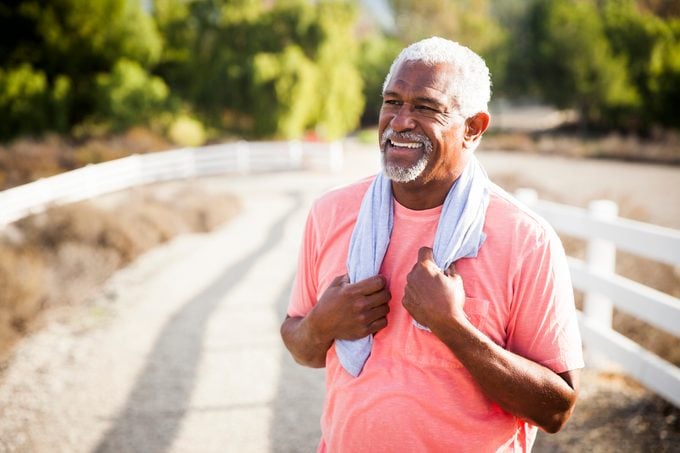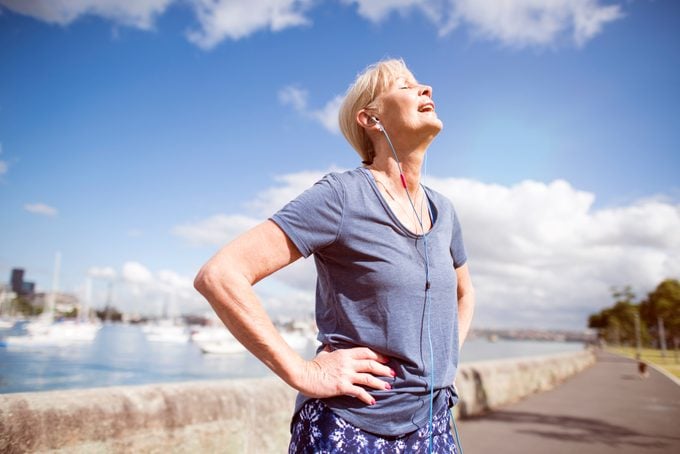The Best Walking Workout for Older People
Updated: Apr. 12, 2021
A strength and nutrition coach reveals the benefits of walking for older people and offers a walking workout tailored to all fitness levels.
Putting one foot in front of the other isn’t just a way to get from one place to the next. Walking is one of the most popular types of physical activity. According to the Centers for Disease Control and Prevention (CDC), more than 145 million adults include walking as a part of their physically active lifestyles.
“Walking is a surprisingly powerful way to strengthen your muscles, bones, and connective tissues as well as reduce body fat, increase endurance, and improve cardiovascular health,” explains Adam Rosante, certified personal trainer and strength and nutrition coach in New York City and creator of Gym Class with Adam, free online gym classes for kids. “I program it into all my clients’ weekly workouts, no matter their age.”
The best part? It doesn’t require any special or expensive gear. As long as you have sneakers, you can do it. (Here are the best walking shoes for your feet, according to podiatrists.)

Is walking good for older people?
The short answer is yes—walking is good exercise for older people, who are physically fit and able to do it. For starters, walking is low impact, which means it’s a joint-friendly way to improve your overall health and fitness, explains Rosante. The CDC says that walking briskly for 150 minutes a week, or 25 minutes per day, as your form of moderate physical activity, can actually help keep you healthy and even prevent disease. (Here’s here are the benefits and risks of walking barefoot.)
But that’s just one of the benefits of walking. A 2016 study published in the journal Emotion shows that walking for as little as 12 minutes can boost your mood. And walking with others can benefit your mental health, too. According to the National Institute on Aging, studies show a positive correlation between social interaction and health and well being of older adults. So walking with friends or family is good for your body and brain. (Just be sure to avoid making any of these common walking mistakes.)
What to consider before starting a walking routine
The first step before starting a walking routine, or any new exercise regimen for that matter, is to check with your doctor to be sure it’s safe. While it might feel like walking is simple and anyone can do it safely, it’s a good idea to get a medical professional to sign off on it—especially if you have underlying health issues.
“We might be overlooking a physical health limitation or could uncover one, so it’s always a good idea to chat with your physician beforehand—even just for walking,” says Rosante. (Here are ways to make your daily walking habit even healthier.)
Safety and planning for your walks
Before you head out to exercise, it’s a good idea to run through a checklist of all the things you might need in order to plan for the safest workout. “Make sure you’re wearing comfortable shoes, have a bottle of water, and a fully charged phone,” says Rosante. “If you have any medical needs that someone should know in case of an emergency, make sure you have the proper identification on you.”
Safety is of utmost importance, too—specifically if you’re heading out the door for some solo exercise. Be sure to let a friend, roommate, or family member know where you’re going, and for how long you expect to be gone.
This isn’t about being an alarmist, reminds Rosante, but rather planning ahead and being as safe as possible. “After that, if you’re walking alone, you might want to cue up some music and bring a pair of headphones,” he says. “Just don’t have the music so loud that you can’t be mindful of car and bike traffic as you walk.”
Overuse injuries from walking
While you might think of walking as being an activity that’s hard to overdo, you can, in fact, have some issues if you jump in and try to do too much, too soon.
“There are some potential overuse injuries to be aware of such as plantar fasciitis, tendinitis, blisters, shin splints, and metatarsalgia,” explains Rosante. “In the case of metatarsalgia, there may be a tear in the ligaments. But for the most part, these conditions are caused by some form of friction or inflammation in the tissues.” Metatarsalgia is a pain in the ball of the foot that can sometimes include numbness and tingling in the toes.
It’s important to evaluate and be honest about your fitness and activity level before beginning this walking program. To avoid the injuries mentioned above, you should start slow. If you’ve been sedentary for a while, jumping into a new program can cause aches and pains. (Here’s what to do if walking causes lower back pain.)
Here are some other tips from Rosante to help ensure you have injury-free workouts:
- Wear comfortable shoes—and be sure that they fit properly. “Use inserts if you need them,” says Rosante.
- Choose moisture-wicking socks, which will help keep things from getting too hot and sweaty. “Cotton socks, while cheap and accessible, hold sweat, which can exacerbate the friction,” says Rosante.
- Use daily self massage on the muscles behind and along both sides of your shinbones and calves, Achilles tendon, and bottoms of your feet. “This can help break up tight tissue and ward off inflammation,” says Rosante.
Keep in mind that if you’re feeling any kind of pain, don’t ignore it and try to power through. “Rest and ice the irritated area,” says Rosante. “Once you’re feeling less inflammation, gently resume activity.” If you don’t see improvement, get in touch with your doctor right away.
Ready to get in more steps per day? Rosante shared a four-week walking workout plan, perfect for older people of all fitness levels. Below is the overview and breakdown of each days’ walk. “While this program is designed to be doable for all levels, you need to listen to your body and talk to your doctor if you’re feeling any pain,” explains Rosante. “It’s always smart to ease into any workout program.”

4-Week walking workout plan for older people
Overview:
This four-week challenge builds on itself each week, increasing in both time and intensity, to improve your overall health and fitness, and to help boost your mood.
Instructions:
- Each workout will be done for a set period of time.
- Workouts are set by week.
- Glance at your guide for the day’s workout (depending on what week you’re in) before you head out on your own, or with family, or friends
- Set a timer on your phone or watch at the start of each session so you’re able to keep track of the intervals
- There are a set number of sessions, per week. Note that this is a minimum. You can do more if you’d like to and are able to.
- Schedule your workouts into your calendar just before the start of each week to help hold yourself accountable.
Week 1 (3-4 total sessions this week)
20 Minutes
- 5 Min: Warm up at an easy pace
- 10 Min: Speed up to and maintain a brisk pace
- 5 Min: Cool it down to an easy pace
Week 2 (3-4 total sessions this week)
25 Minutes
- 10 Min: Warm up at an easy pace
- 10 Min: Speed up to and maintain a brisk pace
- 5 Min: Cool it down to an easy pace
Week 3 (4-5 total sessions this week)
30 Minutes
- 10 Min: Warm up at an easy pace
- 15 Min: Speed up to and maintain a brisk pace
- 5 Min: Cool it down to an easy pace
Week 4 (5-6 total sessions this week)
40 Minutes
- 15 Min: Warm up at an easy pace
- 15 Min: Speed up to and maintain a brisk pace
- 10 Min: Cool it down to an easy pace
Want to power up your walk a bit? Try incorporating these six steps from Rosante.
Six ways to power up your walk
Change your walking terrain
“Changing up the type of ground you walk on is an awesome way to challenge the ways your muscles and joints work,” says Rosante. “Grass, asphalt, dirt, trails, you name it. Stay safe and see how a different environment changes things up in your body and brain.”
Reverse your walking route
“If you have a walking route you love, stick with it, but go in the opposite direction,” suggests Rosante. “The change in routine will keep things feeling fresh and give you a different perspective on a familiar journey.”
Pick up your walking pace
“Stick with the same route for at least two days,” says Rosante. “Each time you walk, try to cover more ground in less time.”
Add some mindfulness to your walk
“As you walk, focus on the feelings in your body—the way your feet feel as you take each step; the way your muscles feel on every stride,” says Rosante. “You can also pay attention to the feelings Mother Nature is casting as you walk—the sun and wind on your face and hands. ”
Muscle up
“If you’re cleared for exercise and feel like giving yourself an additional boost, throw in some bodyweight strength training along your route,” recommends Rosante. “Add in squats, reverse lunges, and push ups every few minutes.” (Check out these easy exercises seniors can do at home or anywhere.)
Brag a bit
“Share your progress on social media and with your friends and family,” says Rosante. “It’s a great way to inspire other people to get out there and get moving! ”















